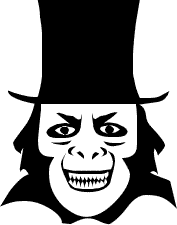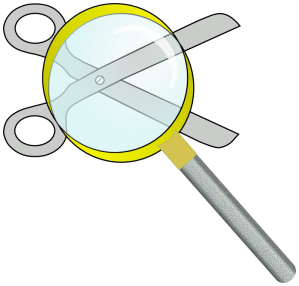Visual Shortcuts that Cut
As both a writer and a reader, I’m always trying to figure out why authors do some of the things we do: End scenes in particular ways, juxtapose dialogue and description, harness the rhythm of words to craft verbal songs…
Maybe it’s due to my rather colorful political sensibilities, or maybe because my dissertation focused on, in part, lookism, but I’m especially sensitive to the symbolism contained in the physical descriptions of literary characters. As I’ve written about before, I’m pretty devoted to making sure I represent under-represented physicalities, and I particularly delight in subverting traditional physical tropes. Given all this, I find it so disappointing when I read books that reinforce all the old, tired symbolism surrounding characters’ physical presentations.
You know what’s super fun and reflects a lot more creativity than relying on the usual physical symbols? Messin’ with ‘em! So, for example, in Hunted, my very first publication, I decided to make my villain a young, Japanese American woman. She’s pretty beautiful – far more so than Gray, the shero – but not in a seductive, Dragon Lady way (yawn). Instead, she’s kind of a sociopathic Valley Girl: cute, perky, deadly, and not exceptionally bright.
I pepper my stories with characters with hooked noses, mental and physical disabilities, and larger body frames. My sheroes are not beautiful. Wrinkles don’t automatically mean either wisdom or senility. Lustrous hair and white, even teeth don’t always equal fine moral characters. Fat characters aren’t representatives of greed and gluttony – nor are they necessarily jolly.
I mean, we writers create our characters from tops to toes. We decide whether they’re short, tall, thin, fat, wrinkled, smooth, dark-skinned or light-, and so on. I understand the appeal of using a visual shortcut, a cultural cliche, to do some of the explanatory work for us. Here’s the fun part: Using these cliches in order to redeploy them in more mindful and subversive ways. For example, imagine a short, White, balding man whose belly overhangs his waistband and whose toupee could use some sprucing. He’s gotta be a used car salesperson, right, or maybe a mafia don? Someone greasy, unenlightened, underhanded. Heck, he’s probably three seconds away from leering at the shero or saying he likes a spirited filly.
Take two. Now picture the man above and imagine your readers’ surprise when they discover he’s an angel in human skin (literally or not, depending on your genre). This guy with the bad rug is the embodiment of kindness, generosity, and creativity. Maybe he’s a professor of anthropology who focuses his research on the rights of indigenous populations or a worker at a nonprofit organization that collects coats and shoes for homeless children.

“Hi! Glad to meet you. I’m off to my job as a social worker after volunteering at the homeless shelter.”
See, there’s a freshness, a downright coolness, in intentionally wielding common visual shortcuts — and then inserting something unexpected. I suppose my heroes could all be tall and muscular with a crop of eyelashes that weigh more than the average dust mop and their ex-girlfriends could be the icily beautiful, blonde bitch whose appeal is never quite explained. But, you know, why?
Visual shortcuts have their place, but when we start using them in place of thinking, as visual clichés, we’re doing our characters and our readers a major disservice. After all, there are a lot of plump, crooked-teethed sheroes out there waiting for their Prince Charming and a number of rakish, black-haired, cleft-chinned gents plotting their next round of check fraud.




As always: well said, well thought, and well hearted. :-)
ReplyDeleteThanks, LJ! I'm pleased this spoke to you. :)
Delete